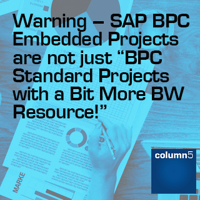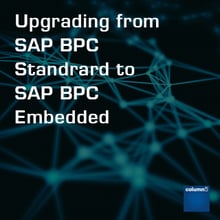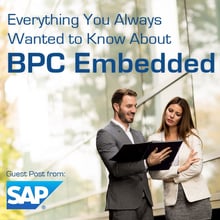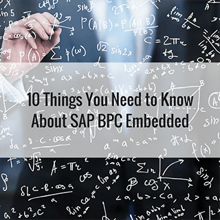 The number of SAP BPC users evaluating SAP BPC Embedded and SAP BPC Optimized is growing. In many ways SAP BPC Embedded is an exciting option because it is fast performing and highly integrated with core SAP financials (S/4HANA Finance). We think Embedded is an option well worth exploring for all SAP BPC users, but we also want those users to be well informed, particularly if they don’t have a strong SAP BW and SAP BW-IP background. This article is the first in a series of blogs where we take our experiences of all flavours of SAP BPC and apply the learnings for those looking at Embedded.
The number of SAP BPC users evaluating SAP BPC Embedded and SAP BPC Optimized is growing. In many ways SAP BPC Embedded is an exciting option because it is fast performing and highly integrated with core SAP financials (S/4HANA Finance). We think Embedded is an option well worth exploring for all SAP BPC users, but we also want those users to be well informed, particularly if they don’t have a strong SAP BW and SAP BW-IP background. This article is the first in a series of blogs where we take our experiences of all flavours of SAP BPC and apply the learnings for those looking at Embedded.
In this blog we will present the comparison of skill sets required for SAP BW-IP, BPC NetWeaver (NW) 10.1 Standard and BPC NetWeaver (NW) 10.1 Embedded. We will highlight the skill sets possessed by a typical BW consultant and the delta skill set required, at a minimum, to be able to implement a BPC NW 10.1 Embedded solution.
The implementation of an SAP BPC NW 10.1 Embedded application requires a good mixture of skill sets as shown when comparing Table 1 and Table 2 and summarized in Table 3 below. Businesses should be extremely cautious in assuming that the implementation of BPC NW 10.1 Embedded can be done just with the help of SAP BW and BPC NW Standard consultants. In our experience observing some of the early Embedded projects, this may well lead to confusion, significant challenges and in some cases may put your project at risk. The consultants need to have a very specific mixture of skills including SAP BW, BW-IP and BPC NW Standard to be able to implement the BPC NW Embedded application successfully and on-budget.
In our experience, a typical BW consultant normally doesn’t understand the planning concept of BW-IP or BPC. They may be excellent BW application consultants with great knowledge around reporting and data warehousing, but the BW-IP application requires extra skills on top of traditional BW skills. A good BW-IP consultant needs to have a thorough understanding of planning concepts, planning business processes and the financial elements of planning as well as expertise in the technical configuration of BW-IP components, expertise in FOX programming and knowledge of coding BADI’s. This is quite a rare skill set! So, to help understand the skill mix needed in your Embedded team let’s look at the different SAP tools and associated skills.
BW-IP
SAP BW-IP was developed as an additional planning functionality for BW and as such was primarily envisaged as an IT-owned and managed application. From the Finance and Business owners’ perspective, this resulted in reduced control, ownership and flexibility of the planning process in their organisation. The reduction in control, ownership and flexibility is an issue we often hear about from Business users in organisations using BW-IP.
Overview
- BW-IP has existed since BW 7.0 (2007).
- Provides an Enterprise Data Warehouse planning solution that directly uses 'native' BW objects.
- BW-IP is completely generic planning application developed before SAP’s acquisition of BPC.
- BW-IP comes with a planning application starter kit (PAK).
- BW has a Warehouse Management and Reporting component, requirements are driven by IT concepts (cf. Central data models, single point of truth...). This also applies to BW-IP.
- BW-IP is typically developed and maintained by the SAP BW-IP team.
- BW-IP comes as a part of BW, so no IP licences are necessary (some additional BW licences may be required for planning users).
BPC NW 10.1 Standard
SAP BPC NW 10.1 Standard is the latest in the line of products that follow this philosophy of giving ownership of BPC Master data and transactional data to the Business function. The drawback here, of course, is that time and effort must be invested in ensuring that the BPC application is in sync with the underlying BW data.
Overview
- ‘BPC Standard', for the NetWeaver platform, is a planning, reporting and consolidation solution based on BW technology.
- It is designed to be used and maintained by the Business team after the initial build by IT.
- The technical BW objects needed are generated and controlled by an administrative interface in BPC, and the underlying platform is not directly exposed in BPC.
- BPC introduces specific concepts which are different from traditional BW concepts.
- In 'BPC Standard' all Master data, hierarchies and transaction data has to be copied over from BW to a unique BPC namespace, and the copied data aligned.
- This can be automated during the initial BPC build to ease subsequent maintenance.
- Additional BPC software and licences need to be purchased.
BPC NW 10.1 Embedded
SAP BPC NW 10.1 Embedded has been developed by SAP to give the Business function the flexibility that they need when planning, forecasting, consolidation and reporting, while the application is wholly integrated with BW, which means sharing ownership and maintenance of the application between the IT department and the Business function. The strengths of SAP BW-IP have been amalgamated with the strengths of BPC, in particular, flexibility and end user features. This makes it an attractive upgrade path for BW-IP users. Because of its integration and performance, BPC NW 10.1 Embedded is also an attractive option for planning and forecasting for BPC Standard users.
Overview
- ‘BPC Embedded’ was created to add BPC Master data flexibility to BW-IP.
- No data needs to be copied; BW-IP/PAK data models and engines are used.
- Central BW objects are enhanced by Business Administrator-owned extensions.
- Special real time capabilities are supported when implemented with S/4HANA (this version is then referred to as BPC Optimized).
- BW Master data, hierarchies and InfoProviders can be extended with Business-owned Master data (new values, new attributes).
- The Business team then has control of Master data via a BW interface, not via the HTML5 BPC web interface.
- Transaction data authorizations are granted by IT, and within this IT-controlled range the Business controls restrictions.
- The Business team has control of the transaction data.
- Many BPC concepts are reused in 'BPC Embedded’.
- Additional BPC software and licences need to be purchased.
So, how does all of this information impact the types of skills and, therefore, teams that are needed for successful Embedded projects? Well, let’s address this by looking at the typical skill sets needed across each of the BPC variants. The tables below explain the roles by team and skill set required by each variant of SAP BPC:
Team Roles and Skill Set Required - SAP BPC NW 10.1 Standard |
||
|
Business User Responsibility |
BW Application Team |
Skill Set Required |
|
|
BPC NW 10.1 Standard:
SAP BW:
SAP BW-IP: Not required |
Team Roles and Skill Set Required - SAP BPC NW 10.1 Embedded |
||
|
Business User Responsibility |
BW Application Team |
Skill Set Required |
|
|
BPC NW 10.1 Standard:
|
Let’s look at this another way. The table below show the skill set required by SAP Application including SAP BW, SAP BW-IP and the BPC variants.
Summary |
|
|
Application Area |
Skill Set Required |
|
SAP BW
|
Expertise in BW application areas:
SAP BW-IP: Not required |
|
SAP BW-IP
|
Expertise in SAP BW:
Expertise in BW-IP:
|
|
SAP BPC NW 10.1 Standard
|
BPC NW 10.1 Standard:
SAP BW:
SAP BW-IP: Not required |
|
SAP BPC NW 10.1 Embedded
|
SAP BW:
BPC NW 10.1 Standard:
SAP BW-IP:
|
A Personal View by the Author
In my experience, I have also seen that if a consultant has a strong background in SAP BW and BPC Standard and has only recently developed skills in BW-IP, the implementation still is at snignificant risk of not being successful. The core issue is that the consultant will inevitably be thinking about the implementation with a BPC NW Standard mindset. This issue is in principle an Account Based Model (Note 1) (only one key figure and hence multiple accounts needs to be created to be able to capture different values like amount, quantity, etc.). They typically fail to realise that SAP has the BPC NW Embedded application so that they can utilise the power of SAP BW and BW-IP which in principle is a Key Figure Model (Note 2) (more than one key figure is available to use and hence no need to create multiple accounts as in the Account Based Model).
Consultant with BW and BPS Standard experience typically seem to be very confused with the naming convention of members and will create various dummy members specifically for planning purposes, a very typical way of working in BPC NW Standard, but not in BPC NW Embedded. BPC NW Embedded follows the BW naming convention and principles to maintain Master data.
Also, consultants with a BPC Standard background seem to be struggling to understand the BW Matrix security concept specifically designed for BW-IP as security in the BPC Standard model works very differently. The danger is that in such circumstances, the implementation project could still perform the required business functions but it will be missing the real capabilities and power of the BPC NW Embedded application which means business benefits will not be fully realised.
Our Recommendation
So, what do we recommend at Column5? The implementation of the BPC NW Embedded model may sound similar to BPC NW Standard model and require very similar skills, but this is far from reality. BPC NW Embedded model requires expertise in various applications (BW, BW-IP, FOX, BPC, BEX Queries, Analysis for Office) as well as an appreciation of the business processes and financial requirements.
The selection of consultants for an Embedded project needs to be done very carefully. You need to consider the mix of skills needed and expertise required (see our tables above). The consultants selected should have the capability to be able to scope the end to end solution integrating all the environments from the real Embedded application perspective utilising the power of SAP BW, BW-IP and BPC while melding this with clear knowledge of the business planning and forecasting processes the solution needs to support.
To help businesses and organizations be successful with BPC Embedded, Column5 has created a Centre of Excellence for Embedded. We have brought together consultants who have real world experience working with BPC Standard, BW-IP and now BPC Embedded directly with organizations. Skills are shared and experiences leveraged to make sure the consultants that Column5 has working on Embedded projects fully appreciate the wide range of blended skills they need and have access to deep experts in each of the application areas. This is why BPC Embedded projects that our CoE consultants have been engaged with have all been successful and delivered significant value to the organizations involved. Feel free to talk to us in the BPC Embedded Centre of Excellence to get a real appreciation of what is needed for your Embedded project success.
Interested in learning more about SAP BPC Embedded, Standard, and BW-IP? Check out our free SAP BW-IP vs SAP BPC 10.1 Standard vs Embedded eBook!
Note 1: The Account Based Model is a form of modelling organized in accounts and using an account-based valuation approach. The distinguishing characteristic of this form is its use of cost and revenue elements. It provides a profitability report that is permanently reconciled with financial accounting.
Note 2: Key Figure Based Model is a form of modelling that group’s costs and revenues according to value fields (different Key figures) and costing-based valuation approaches, both of which can be defined by the developer. It guarantees access at all times to a complete, short-term profitability report.
Interested in learning how SAP BPC Embedded stacks up? Check out our free SAP BW-IP vs SAP BPC 10.1 Standard vs Embedded eBook!
More Content You Might Like:
 Author Bio:
Author Bio:
Sumit Goenka has provided value adding solutions to organisations in the area of Data Warehousing, Business Intelligence/ Analytics and Enterprise Performance Management for over 14 years. He has particular expertise in Enterprise Performance Management (EPM) through implementing Planning, Budgeting, Forecasting and Management Reporting solutions at a wide variety of clients for the last 8 years. He has worked with SAP BPC Standard and BW IP but for the last two and half years he has specialised in SAP BPC Embedded and lead one of the first UK SAP BPC Embedded on HANA projects.
Sumit Goenka, Senior Consultant and Member of SAP Embedded Centre of Excellence at Column5














